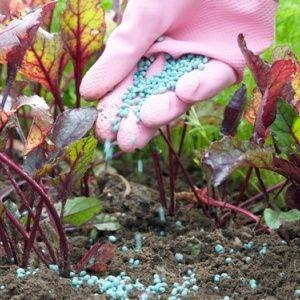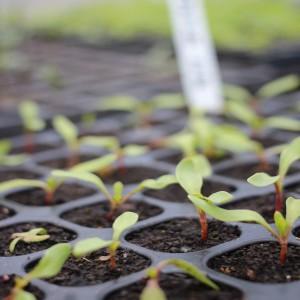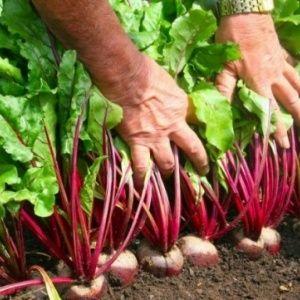How and when to plant beets for seedlings: timing of sowing seeds and further care for them
Beet- a widely cultivated root crop among gardeners. Basically, it is planted immediately with seeds in the beds, but to get an early harvest, the crop is grown in seedlings. How and when to plant beets for seedlings - further in the article.
The content of the article
How to prepare seeds for planting
Beets contain many vitamins and minerals. Even boiled, this product retains all the beneficial properties. Before planting beets, gardeners have a question: how to properly prepare seeds for sowing to get a good harvest?
Beet seeds germinate very slowly, so it is important to prepare them correctly for sowing. This process is carried out in several stages.
Selection and processing, germination
At the first stage, we perform calibration. We select only large undamaged specimens. If there are a lot of them and it is difficult to select by hand, sift through a large sieve or colander. Throw away small and damaged specimens.
The following solutions are used for processing:
- boric acid solution (1 g per 5 l of water);
- manganese solution (1 g per half bucket of water);
- ash solution (1 tbsp. l. per 1 liter of water);
- copper sulfate (1 g per half a bucket of water);
- infusion of calendula and chamomile;
- growth stimulants (Epin, Zircon, Agricola vegeta, etc.).
The seed is soaked in a container with a solution for 10-12 hours.
The next step, before planting, is laid out on a cotton cloth or napkin, moistened with water and placed in a container. All this is removed to a warm place with a temperature of 20-22 ° C.
Periodically, the cloth is gradually moistened with water so that the germinating seeds are constantly moist. Seed material is kept in wet tissue for 2 days. Periodically, the contents are ventilated to prevent mold from forming.
As soon as the first white sprouts appeared, they begin earthworks. The advantage of this preparation is that the seeds germinate as early as 4-6 days after planting. That is, much earlier than when using dry seed.
When to plant beets for seedlings
 The timing of planting beets depends on the climatic conditions of a particular region. For example, in Siberia, in the Urals or in the middle lane, the culture is planted not earlier than May, mainly in the second half of it.
The timing of planting beets depends on the climatic conditions of a particular region. For example, in Siberia, in the Urals or in the middle lane, the culture is planted not earlier than May, mainly in the second half of it.
In southern latitudes, beet seeds are sown in the second half of March or April. In areas of the middle zone - from early to mid-May.
Also, most gardeners for better plant germination are guided by the lunar calendar. The best time is the waning moon period. At this time, the plants take root well and grow.
Planting seedlings and sowing seeds is undesirable to carry out during the new moon and full moon. The plants planted at this time do not take root well and grow slowly.
reference... Favorable days for planting according to the lunar calendar differ between calendar years. The lunar calendar does not depend on the traditional one.
Growing beets in seedlings
To get a high-quality beet harvest on time, take care of the seedlings in early spring. Planting root crops in open ground with seedlings will give an earlier and larger harvest than seeds. The algorithm described below will help to achieve the expected result.
Site and soil preparation
The soil for sowing beets for seedlings is used from the store or prepare the mixture yourself. To do this, mix:
- 2 parts of peat;
- 1 part rotted compost or humus;
- 1 part of garden or turf land;
- 0.5 parts of washed sand.
On a note. Acidic soils are not suitable for beets, so half a glass of wood ash per 5 liters of composition is added to the mixture. Ash is an excellent fertilizer for beet seedlings, due to its high content of nutrients.
The mixture is sieved and steamed for an hour. Instead of steaming, some water the substrate directly in a sowing dish with a fungicide solution ("Maxim", "Vitaros", "Fitosporin").
The seeds are treated with a fungicide solution according to the instructions on the package. This prevents the defeat of the beet by fomoz. This disease forms voids and rot in roots. The soil mixture is placed in a bowl, compacted and seeds are spread over the surface. The main thing is that the landing capacity is high enough.
Landing
The rules for growing seedlings are quite simple: as the soil dries up, watering is needed, as well as a lighted place.
Important! With the appearance of 2-3 true leaves in the seedlings, a small plant is transplanted into open ground.
With the correct procedure, seedlings will appear on the 4th-6th day. Almost immediately after germination, the soil is loosened to allow air to flow to the roots.
Further care
It is important to water, weed, loosen and feed the beet beds in a timely manner.
Many experienced gardeners feed the beets with a mullein (1: 6), in addition to the main elements, it contains copper, boron, molybdenum and other necessary substances to obtain high-quality root crops.
When using mineral dressings, keep in mind that nitrogen is most needed by a vegetable at the beginning of growth. When a root vegetable is about the size of a walnut, nitrogen builds up in the form of nitrates. Therefore, at the beginning of cultivation, nitrogen fertilizers are applied in fractional portions, and when the leaves close, they begin to use phosphorus-potassium fertilizers.
If there is not enough boron in root crops, voids form in them. To prevent ailment in cloudy weather, carry out foliar feeding on the leaves (2 g of boric acid per 10 liters of water). In order for the beets to be sugary, they are watered 2 times per season with a solution of sodium nitrate (1 tbsp. L. Per 10 l of water) or table salt (2 tbs. L. Per 15 l of water).
On a note. Beets will grow better if planted in one row along the edge of other crops (tomatoes, onions, potatoes).
Thinning and planting
Thinning the culture is mandatory in moist soil (after rain or watering). This is done in non-sunny weather.
For your information. It is recommended to water the beets over the tops so that the leaves receive moisture.
During the season, beets are usually thinned 2 times:
- The first thinning is performed as the first 2-4 true leaves appear on the tops, with a bush height of about 7-8 cm. The task is to remove the weakest plants in the row. They also pull out those shoots that are as close as possible to others, leaving about 5-8 cm between the plants.
- The second time, the beets are thinned after the ovary of the root crops. About 8-10 cm is left between the plants.
Also, with thinning, only weeds that have hatched are pulled out. If you have to remove rather strong plants, most summer residents do not throw them away. After thinning, excess root crops go for cooking, and are also planted in other parts of the site.
How to plant beet sprouts? This is not difficult. First, recesses are made in each row with a marker at a distance of about 3 cm. Pour water from a watering can into each such hole. Then they take seedlings (ideally if they are in the phase of 2-3 or 3-4 leaves), plant in holes, and strengthen them with earth. In this case, the root must be pinched a quarter of the length. After planting, water the garden bed again and mulch with sawdust.
Read also:
Is it possible to eat beets with gastritis.
How to grow and when to harvest beet seeds.
A delicious doctor straight from the garden - boiled beets: benefits and harms for the liver.
When and how to transplant seedlings into the ground
Sowing beets in open ground is easier than using seedlings. But the second option is better in that the harvest is obtained in a shorter time. This vegetable tolerates picking well.... This is done at home in boxes or in a heated greenhouse.
The prepared seeds are planted on seedlings about 4 weeks before planting seedlings in open ground. For disinfection, the seed is soaked in a weak solution of potassium permanganate, then the seeds are kept in a humid environment for 2-3 days so that they hatch, and finally they are laid out in a box in a soil etched with Fitosporin, which will prevent black leg disease. The seeds are sprinkled with the same soil and placed in a greenhouse.
Important! Seedlings require moist soil and daily ventilation.
To transplant beets with seedlings, a denser planting scheme is used than when planting directly into open ground. The distance between the rows is 5 cm, between the plants - 2 cm. The depth for sowing is not more than 3 cm. The seedlings are thinned out about 7 days after germination. The remaining shoots should not touch each other with cotyledon leaves.
To the greenhouse
Planting beet seedlings in protected ground conditions is quite justified, since the sugar root crop is not a frost-resistant crop.
After germination of seedlings in special cassettes, it is necessary to thin out and dive young shoots. After 6-7 days, it is better to move the seedlings to the greenhouse from exposure to sunlight.
To obtain an early harvest, seedlings are placed in greenhouses in the first half of autumn, and for a late harvest, in the first decade of April. The process of growing seedlings in a greenhouse begins with grooves in the ground, the distance between which should be about 5 cm. In a couple of weeks, the seedlings will grow up and get stronger. When 2 leaves appear, the plant is ready to be transplanted to a permanent growing site.
Important! A few days before picking plants in open ground, it is necessary to harden by airing the greenhouse.
After the formation of the first or second true leaves, a pick is made. At the stage of the third or fourth leaf, the beets are transplanted to a permanent place according to the scheme of 10 × 25 or 15 × 25 cm.The transplant is done very carefully so that the main root of small plants is not damaged.
Seedless way
Many novice gardeners think that planting beets is a troublesome and difficult process. In fact, it is not difficult at all, but at least basic knowledge is necessary.
In open ground
To make the seeds germinate faster, you need to soak them for a day in cold water or for 40 minutes in warm (35 ° C). Also, to speed up the process, some gardeners use a growth stimulant, keeping the seeds in it for about a day.
The grains are placed in moist open ground to a depth of no more than 3 cm.The distance between the rows is from 25 cm for large varieties, for small varieties from 6 cm.The gap between the bushes in a row is from 8-10 cm.
The seed is placed after filling the grooves with water and absorbing it. Since beet seeds are large in size, they are placed in the soil one by one. Many varieties are formed by 2-3 fruit, which means that thinning will be required at the initial stage of development.
While the plants are young, it is necessary to transplant elongated shoots. They will take root easily. With the first thinning, excess weeds are removed from the beds and the soil is loosened, after which they mulch (for example, with sawdust).
The second thinning is carried out after the appearance of two paired leaves, when the root crop becomes about 1.5 cm in diameter. Thinning and weeding is best done after rain or watering, so it will be easier to get rid of weeds. As the bushes develop, top dressing is applied: first, organic matter, and then - mineral fertilizers.
To the greenhouse
Correct seed preparation accelerates the appearance of the first shoots several times. Preparation is made as follows:
- choose the largest seeds;
- soaked in water or a solution with trace elements;
- germinate;
- disinfect and carry out bubbling (treatment in water with oxygen or air).
The seeds are soaked at a temperature of 20-22 ° C, then they are collected in a cotton bag and placed in a container, periodically moistened, the procedure lasts 2 days. At the end, when the first shoots appear, the seeds are dried to a loose state.
Advice... Soaking the seeds in a solution with mineral fertilizers will accelerate the emergence of sprouts. For 1 liter of water add 1 teaspoon of "Superphosphate" or soda, still use "Nitrofoska".
After a day or earlier, the seeds are washed under running water. Disinfection of the seed is carried out with a weak solution of potassium permanganate - this is useful in the fight against the root root.
Plants need to be thinned after germination, leaving a distance of 8-10 cm between the bushes.
If the seeds are planted in February, the harvest will be in May, and the planting in March will bring the harvest in June, depending on the warming up of the soil (the desired temperature is + 8-10 ° C). It will take 1.5-2 g of seeds per square meter, which should be sown to a depth of no more than 3 cm.
The choice of variety is also important. Experienced indoor gardeners recommend choosing the following varieties:
- "Bordeaux";
- "Ataman";
- "Red ball";
- "Cylinder";
- "One-sprout";
- "Cold resistant";
- F1-Pablo;
- "Detroit".
In addition, breeders have developed special varieties that are well suited for cultivation in a greenhouse. These include Boltardi, Pablo and Burpiz Golden.
Conclusion
If beets are planted in open ground as seedlings, the roots will have a richer flavor. The seedlings take root well and avoid further thinning, which, in turn, will simplify their care. Many gardeners who have tried to grow seedlings of beets use this method every year.
The following video will help you learn about an alternative way to grow beets for seedlings: